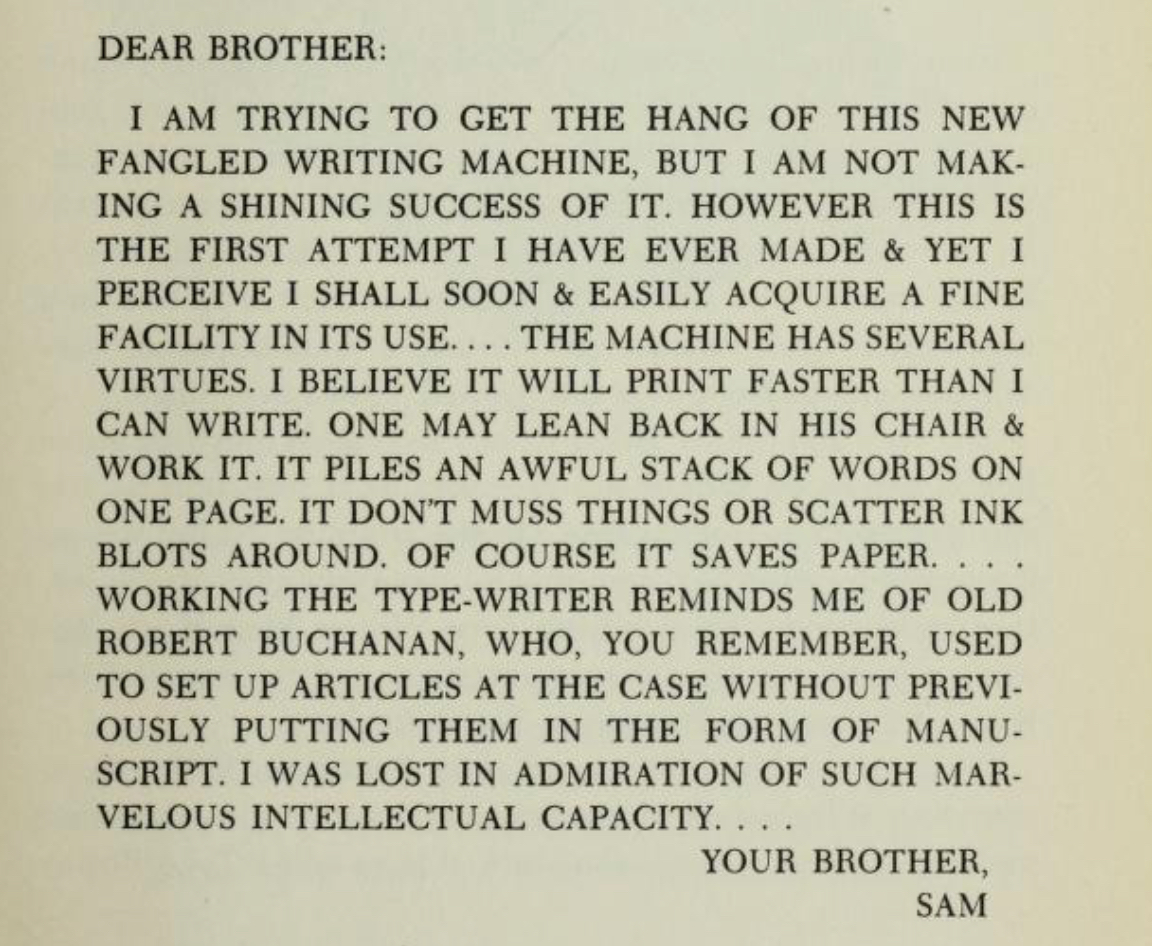
Want to apply this essay to your work? Watch a 40-minute self-paced workshop on writing with AI, and practice with custom exercises.
You'll learn how to use AI as a creative tool to help you do the best writing of your life.
Curious? Learn more:
There’s a new writing technology that draws big crowds to see it used in eye-popping demonstrations. But while there’s excitement about it in some quarters, there aren’t many people actually using it.
Instead, there’s skepticism and even anger. Reading something written with it feels insulting. It’s too impersonal, and lacks a human touch. It comes off like bland corporate marketing. Not only that, but using it is expensive, and it feels like an invasion of privacy.
We’re talking about AI writing, right? No, we’re talking about typewriters.
If you read histories of typewriters, you’ll find that each one of these concerns—too impersonal, not private, too much like corporate marketing, too expensive, too much hype and not enough use cases—were brought up by people encountering them for the first time.
In The Wonderful Writing Machine, a 1954 history of the typewriter, Bruce Bliven writes that when these machines were first introduced, “one real difficulty…was the public’s feeling that typewriting, for private correspondence, was insulting, or confusing, or both.”
Everyone was used to receiving letters from friends, colleagues, and acquaintances written in longhand. Anything typewritten was reserved for handbills—literally, advertisements—and people who received letters written on early typewriters thought that’s what they’d gotten: “Handbills could be [typewritten] but, a good many persons felt, but letters were [supposed to be] written in longhand with a pen and ink.”
Other people were insulted to receive a typewritten letter because they thought it implied that the sender believed they were incapable of reading longhand: “A Texas insurance man, J.P. Johns, one of the early Type-Writer users, sent a typed note to one of his agents and got back an indignant reply:
‘I do not think it was necessary then, nor will it be in the future, to have letters to me taken to the printers’ and set up like a handbill. I will be able to read your writing, and I am deeply chagrined to think you thought such a course necessary.’”
Still others felt that typewriters were an invasion of privacy: “No man was clever enough to run such a machine without a professional operator’s help, and that therefore a typewritten love letter must have been transcribed by a third person.”
In Engines of Democracy, a study of the effect of technology on society in America, Roger Burlingame recounts how in 1876, the Remingtons—manufacturers of the first commercially successful typewriter—sent a machine to the Centennial Exhibition in Philadelphia. They wanted to get it in front of a crowd so they could sell more machines.
Indeed, a crowd gathered to see this new piece of technology. But instead of selling many machines, “the exhibit [returned its investment] chiefly by the sale of typewritten souvenirs at a quarter a piece.”
People were happy to buy cheap pieces of paper with typewritten text on them—the modern equivalent of sharing unhinged Bing screenshots. But no one wanted to buy the typewriter itself—let alone use it for anything important.
Typewriters were bulky machines that violated people’s existing set of expectations about how writing was done and what it looked like. They completely changed how writing worked. They required new skills to operate, and they were expensive.
In short, there were many good reasons to dismiss them, or be suspicious and angry about their use. But slowly they gained fans.
Mark Twain was one of the first to see their promise. We even have his first, faltering attempts to write a letter using a typewriter to his brother:
Over the next few decades, typewriters were everywhere. They transformed media and business, and became one of the first avenues for women to enter the workforce in large numbers.Today, the default way we send text to each other is through typing. Writing longhand is reserved for birthday cards, journaling, taking quick notes, and little else.
I think something similar is going to happen with AI-assisted writing. Today it’s a novelty, a threat, or both. But soon, I think (and hope) it will be regarded as a serious creative tool—not to replace writers, but to help us make great work.
Like Mark Twain, the writers who are prepared to embrace “this newfangled writing machine” will find that if they can learn to work around its limitations, they can already do incredible things with it.
AI has had a huge impact on my writing process
I think AI writing gets a bad rap because there are a lot of misconceptions about what it means and how it should be used.
The primary misconception is that its main use is to replace writing and writers. The caricature of AI writing is that it’s supposed to let you click one button and churn out the next great American novel, or flood the internet with infinite amounts of terrible SEO farm-worthy content.
AI can certainly churn out terrible SEO content. A lot of what it creates is generic, or stupid, or false.
But after my co-founder Nathan incubated Lex, our AI-powered writing app, I’ve been using a whole host of AI tools to help me produce my writing. Sometimes I use Lex, sometimes I use ChatGPT, sometimes I use GPT-3, and sometimes I use something totally different like Otter.
In that time AI has helped me write weekly to the almost 75,000 people on this email list. I’ve generated over 8 million impressions on Twitter. I’ve been interviewed by the Atlantic about how I use it in my writing process.
And I can confidently say that rather than replace me, it’s enabling me to create some of the best work I’ve ever done. I still spend large amounts of time and energy doing the writing that I do—but the writing is coming out better than it ever has before.
In that way, AI is a little like a mirror: it will reflect exactly what you put into it.
If you type a few bland prompts, you’ll get bland completions.
If you push it in a creative and interesting direction, you’ll get creative and interesting results. It works best when it’s used by an experienced and talented writer as another tool in their tool belt.
I want to spend the rest of this piece explaining how I use it, so that you can learn how to do it too.
How to incorporate AI into your writing practice
If we map the writing process out from start to finish, there are a few obvious places where AI can be effectively incorporated. It can help you:
- Get your thoughts down when you want to
- Organize your thoughts before you get started on a piece
- Capture a voice when you want the flavor of a particular writer
- Summarize complex ideas when you’re trying to explain
- Help you when you get stuck
- Evaluate your writing when you need a fresh brain
Before we start, though, let’s get a few things straight.
First, you don’t have to incorporate AI into your writing practice. If you want to keep writing longhand, that’s both fine and preferable in certain cases. The idea of this essay is to inspire you and help you experiment—not to give you the One True Way to write.
Second, you should know that everyone—including me—is making this up as we go. It’s a whole new frontier, so there isn’t any standard or accepted way to write with these tools. All I can share is what I’ve seen work for me and other people.
Third, there are many ways to misuse this tool to make crap. AI is not a panacea for lack of taste or bad intentions. If you’re skilled, though, you can use it to make stuff you love.
Ready? Let’s go.
Get your thoughts down when you want to
Thoughts, feelings, memories, and emotions are the raw material of writing. They pass through our consciousness moment to moment, and writing begins when we determine to note them.
There are many ways to do this in a pre-AI world. You can keep a writer’s notebook in your pocket or a running list in your Apple Notes. You can do Morning Pages every day to get all of your thoughts out and figure out what’s interesting to you.
These methods have their merits, but there are problems too. Sometimes I don’t want to carry around a notebook. And sometimes it feels like a drag to have to write everything out by hand, or type it. It feels like my mind could move more quickly if I could just talk through what’s going through my head.
That’s where you can use AI, if you want to.
What I’ve been doing recently is taking a walk and recording myself free-associating while I’m out. I say anything that comes to mind—good, bad, embarrassing, or otherwise. I feel like a loon while I’m doing it, but I gather a lot of raw material this way.
The Only Subscription
You Need to
Stay at the
Edge of AI
The essential toolkit for those shaping the future
"This might be the best value you
can get from an AI subscription."
- Jay S.
Join 100,000+ leaders, builders, and innovators

Email address
Already have an account? Sign in
What is included in a subscription?
Daily insights from AI pioneers + early access to powerful AI tools











Comments
Don't have an account? Sign up!
Great article Dan! I loved the intro (super funny!) and the workflow. I will make good use of it :-)
To get access to Lex as a subscriber, should I still use the form that was shared back in October in "How to access Lex"?
@Alex Adamov yup! or if you want DM me on our Discord and I'll get you taken care of :)
Apparently, Lex iśnot accessible right now. It put me on a long waiting list
@oluwadiya you should have access if you're a paying subscriber! join our Discord and request it in the #lex channel and we'll get you set up :)